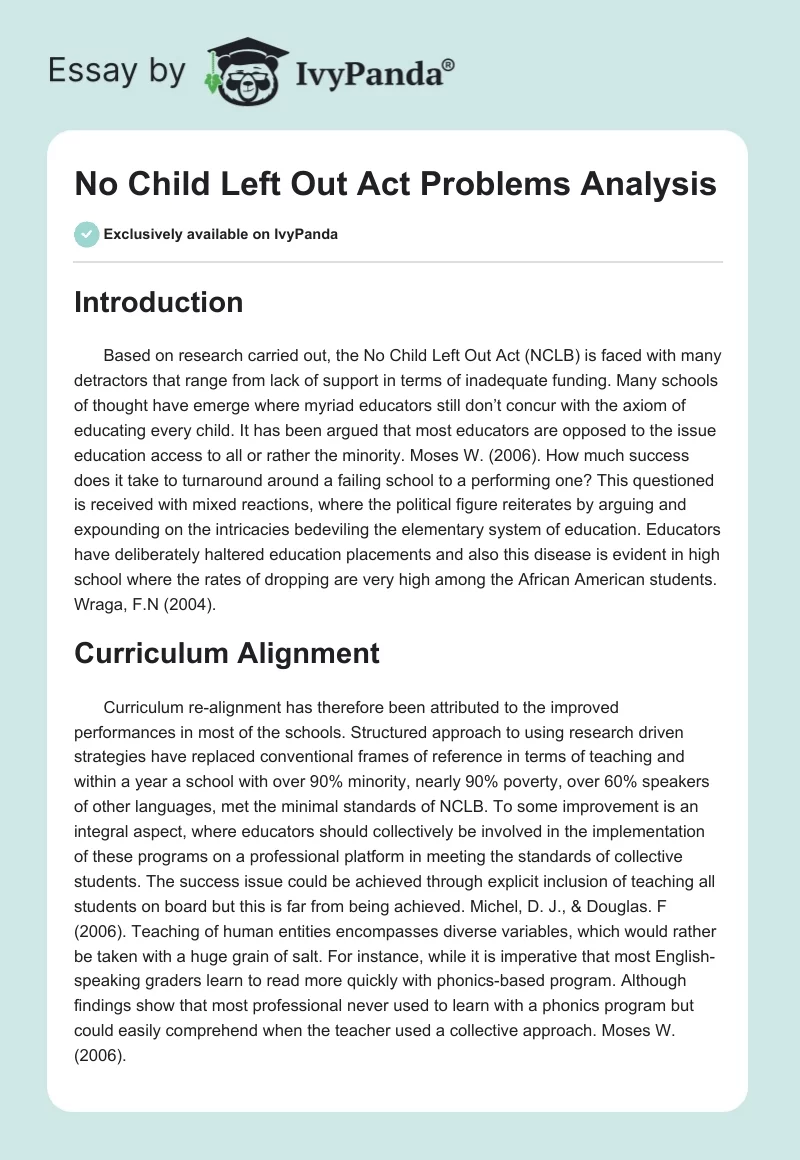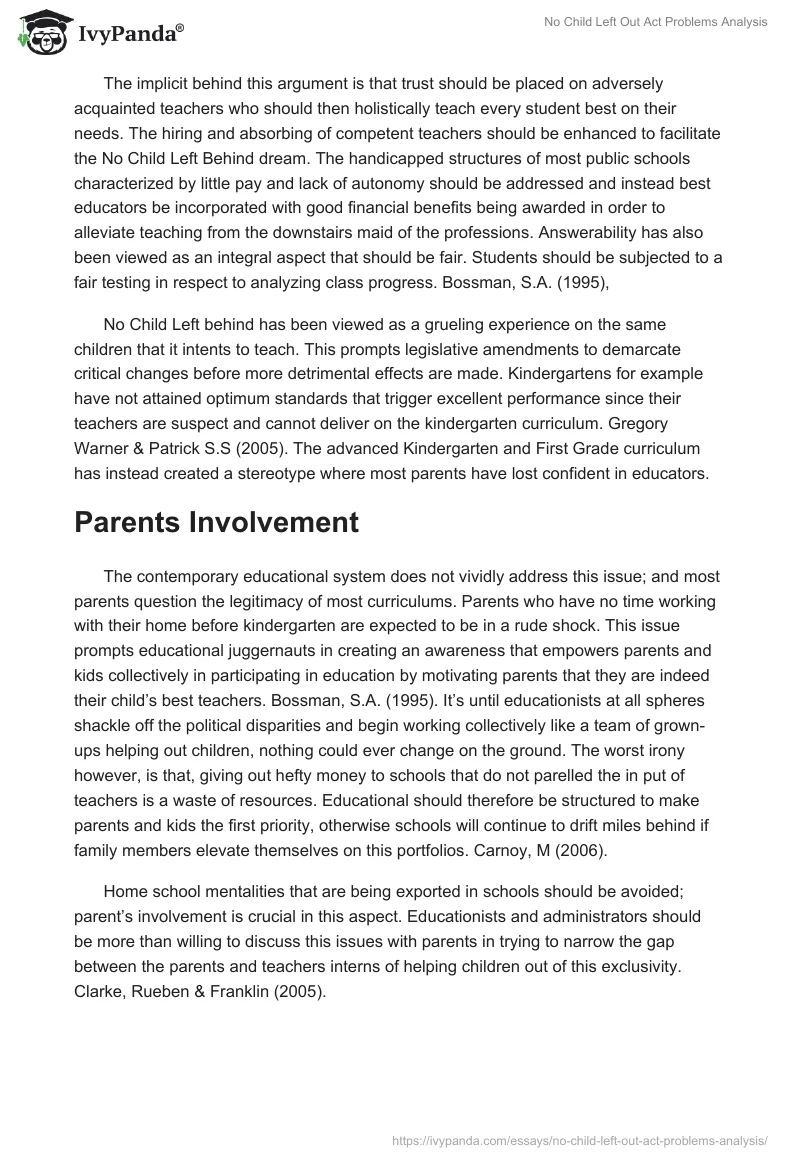Introduction
Based on research carried out, the No Child Left Out Act (NCLB) is faced with many detractors that range from lack of support in terms of inadequate funding. Many schools of thought have emerge where myriad educators still don’t concur with the axiom of educating every child. It has been argued that most educators are opposed to the issue education access to all or rather the minority. Moses W. (2006). How much success does it take to turnaround around a failing school to a performing one? This questioned is received with mixed reactions, where the political figure reiterates by arguing and expounding on the intricacies bedeviling the elementary system of education. Educators have deliberately haltered education placements and also this disease is evident in high school where the rates of dropping are very high among the African American students. Wraga, F.N (2004).
Curriculum Alignment
Curriculum re-alignment has therefore been attributed to the improved performances in most of the schools. Structured approach to using research driven strategies have replaced conventional frames of reference in terms of teaching and within a year a school with over 90% minority, nearly 90% poverty, over 60% speakers of other languages, met the minimal standards of NCLB. To some improvement is an integral aspect, where educators should collectively be involved in the implementation of these programs on a professional platform in meeting the standards of collective students. The success issue could be achieved through explicit inclusion of teaching all students on board but this is far from being achieved. Michel, D. J., & Douglas. F (2006). Teaching of human entities encompasses diverse variables, which would rather be taken with a huge grain of salt. For instance, while it is imperative that most English-speaking graders learn to read more quickly with phonics-based program. Although findings show that most professional never used to learn with a phonics program but could easily comprehend when the teacher used a collective approach. Moses W. (2006).
The implicit behind this argument is that trust should be placed on adversely acquainted teachers who should then holistically teach every student best on their needs. The hiring and absorbing of competent teachers should be enhanced to facilitate the No Child Left Behind dream. The handicapped structures of most public schools characterized by little pay and lack of autonomy should be addressed and instead best educators be incorporated with good financial benefits being awarded in order to alleviate teaching from the downstairs maid of the professions. Answerability has also been viewed as an integral aspect that should be fair. Students should be subjected to a fair testing in respect to analyzing class progress. Bossman, S.A. (1995),
No Child Left behind has been viewed as a grueling experience on the same children that it intents to teach. This prompts legislative amendments to demarcate critical changes before more detrimental effects are made. Kindergartens for example have not attained optimum standards that trigger excellent performance since their teachers are suspect and cannot deliver on the kindergarten curriculum. Gregory Warner & Patrick S.S (2005). The advanced Kindergarten and First Grade curriculum has instead created a stereotype where most parents have lost confident in educators.
Parents Involvement
The contemporary educational system does not vividly address this issue; and most parents question the legitimacy of most curriculums. Parents who have no time working with their home before kindergarten are expected to be in a rude shock. This issue prompts educational juggernauts in creating an awareness that empowers parents and kids collectively in participating in education by motivating parents that they are indeed their child’s best teachers. Bossman, S.A. (1995). It’s until educationists at all spheres shackle off the political disparities and begin working collectively like a team of grown-ups helping out children, nothing could ever change on the ground. The worst irony however, is that, giving out hefty money to schools that do not parelled the in put of teachers is a waste of resources. Educational should therefore be structured to make parents and kids the first priority, otherwise schools will continue to drift miles behind if family members elevate themselves on this portfolios. Carnoy, M (2006).
Home school mentalities that are being exported in schools should be avoided; parent’s involvement is crucial in this aspect. Educationists and administrators should be more than willing to discuss this issues with parents in trying to narrow the gap between the parents and teachers interns of helping children out of this exclusivity. Clarke, Rueben & Franklin (2005).
Conclusion
In a nutshell the curriculum is what is integral; through entrenching of a comprehensive curriculum framework that emphasizes on holistic approaches in teaching models and not obtaining marks is imperative. Jackson, J & Maxwell, G.G (2006). For students to demonstrate learning with ease, creativity should be incorporated, educators should be trained and entrusted with incorporating examination strategies that tally with their students, unlike specification which is rather too demeaning to students who exhibit diverse learning techniques and ingenuity. The notion of enhancing highly merited educators is fundamental for the curriculums to keep on pace with all that is imperative to be a reliable, employed adult and a critical thinker in our society. Carnoy, M (2006)
References
Bossman, S.A. (1995), “Inter-Continental Values for a comprehensive Core Curriculum” Journal of Higher Education, Vol. 30
Carnoy, M (2006) Evaluating Educational Success; Issues and Practice.
Clarke, Rueben & Franklin (2005) Curriculum alignment: Lessons Learnt from the Field.
Jackson, J & Maxwell, G.G (2006) Education Reforms in Elementary Schools;
Gregory Warner & Patrick S.S (2005) Authentic Approach in reforming Elementary Education: Hopkins University Press.
Michel, D. J., & Douglas. F (2006) Curriculum Development and Reform Enhancement. Upper Saddle River.
Moses W. (2006) Instructional Leadership: No Child Left Behind (NCLB) University of Leeds.
Wraga, F.N (2004) The Politics and Philosophies of Curriculum: Journal of Curriculum development;
Michel, D. J., & Douglas. F (2006). Curriculum Development and Reform Enhancement. Upper Saddle River.
Wraga, F.N (2004) The Politics and Philosophies of Curriculum: Journal of Curriculum development


